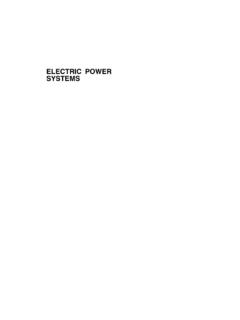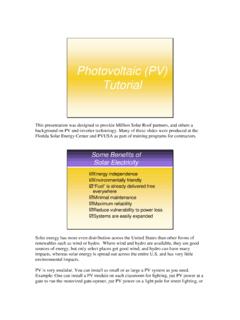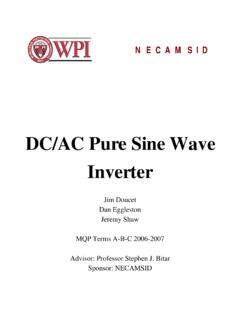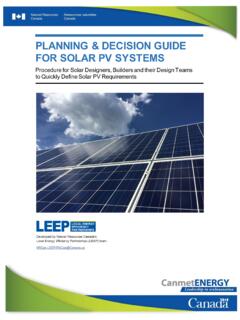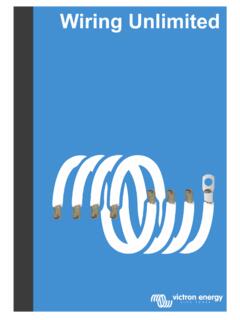Transcription of Advancements in Liquid Cold Plates & Liquid Cooling ...
1 Advancements in Liquid Cold Plates & Liquid Cooling Systems for eMobility Applications Liquid Cooling for electric Vehicles July 2020 Liquid Cooling Solutions in electric Vehicles: Creating Competitive Advantage in eMobility Applications Overview This paper addresses current and upcoming trends and thermal management design challenges for electric Vehicles and eMobility with a specific focus on battery and inverter Cooling . Liquid Cooling is extremely efficient to handle higher heat loads, but systems must be designed to optimize size, weight, performance, reliability, and durability.
2 Through advanced design and technology integration, Aavid, Thermal Division of Boyd Corporation is working with designers to accomplish these goals in a way that meets current requirements, enables next generation innovation, and contributes to overall vehicle performance and driver satisfaction. This article will aid engineers in understanding the role of Liquid Cooling to improve system development and foster design creativity. CURRENT electric VEHICLE MARKET TRENDS The Transportation market is currently undergoing a significant, fundamental transformation towards eMobility.
3 Global trends ranging from environmental awareness, historical gas crises, and urbanization combined with customer demands for greater connectivity, safer driving, maximum efficiency, sustainability and cost savings have culminated in the exponential growth in demand for and use of electric Vehicles (EVs). The global electronic fleet has risen dramatically over the last decade; by 2019 there were an estimated million electric vehicles on the road with market experts estimating that more than half of new cars will be electric by 2040.
4 Concerns the previously limited electric vehicle adoption have been addressed, such as battery costs, safety, reliability, charging station availability, and technology limitations. Currently, batteries charge faster, power is electric vehicles are becoming more prevalent worldwide. Advancements in Liquid Cold Plates & Liquid Cooling Systems for eMobility Applications Liquid Cooling for electric Vehicles July 2020 more efficiently converted and electronics speed, complexity, connectivity and processing power increase.
5 However, a new barrier to market scalability and growth is created as a by-product: more heat. Advancements including longer lasting, higher performing batteries, greater connectivity, more accurate and connected sensors, enhanced system monitoring, faster charging, and improved cabin features are producing much higher heat loads. In addition to this enhanced performance and functionality, Manufacturers are demanding smaller, lighter form factors. The excess heat generated by so much power in such a compact form can easily lead to system failures and threats to passenger safety if not managed efficiently and effectively.
6 Each EV generation has gotten lighter, safer, more reliable and better connected, and will continue to do so for each new model to come. It will be imperative that Cooling solutions progress ahead of vehicle innovation for each new advancement to test and prove safety and reliability. Boyd Corporation and its Thermal Division, Aavid, have aligned closely with key eMobility innovators and design teams over the past two decades to ensure that our thermal management solutions exceed industry Advancements to empower future innovation.
7 This close collaboration has enabled Boyd engineers to anticipate upcoming market changes, industry trends and evolving design requirements to influence our research and development, guide technology roadmaps, and start development early for improved thermal solutions and system integration. This practice not only leads to more optimized, cost efficient Cooling with greater reliability, but also faster time to market, lower overall costs, and a significant competitive advantage to OEMs. SOLVING KEY CHALLENGES IN EMOBILITY Cooling OVERALL ENVIRONMENTAL & USE CONSIDERATIONS There are several critical considerations surrounding all thermal management systems within electric vehicles, one of the most significant being environmental conditions.
8 Vehicles must be able to operate with guaranteed performance, safety and reliability in conditions with varying temperature extremes, humidity levels, precipitation, exposure to sand, saltwater and other environmental factors. Vehicles may also be subjected to rugged terrain, extreme shock and vibration, collision impact, electromagnetic interference from advanced electronic systems and many other factors. Critical components and systems must be designed to protect against known possible hazards while still being serviceable, easily maintained and cost efficient.
9 Inside an electric vehicle: Compact, High performing systems Vehicles must run effectively in harsh conditions. Advancements in Liquid Cold Plates & Liquid Cooling Systems for eMobility Applications Liquid Cooling for electric Vehicles July 2020 Optimized design starts with selecting the best-fit materials for specific performance and environmental exposure in streamlined geometries that integrate multiple functions into a solution that minimizes material and assembly costs, like integrating protection and structural functionality into a Cooling solution.
10 Rigorous testing and quality assurance are also a key aspect to maintain reliable high performance in challenging environments. CHALLENGE: BATTERY & inverter Cooling The most significant technologies engendering eMobility growth and adoption are batteries and inverters, which convert battery energy into mechanical power to propel a vehicle. There is a correlation between battery cost reductions and EV adoption which has led to engineering focus on battery cost savings. Improvements in battery capacity, charge speed and reliability have driven innovation to create lighter, smaller, and higher power batteries for better performance and lower overall cost of ownership.

